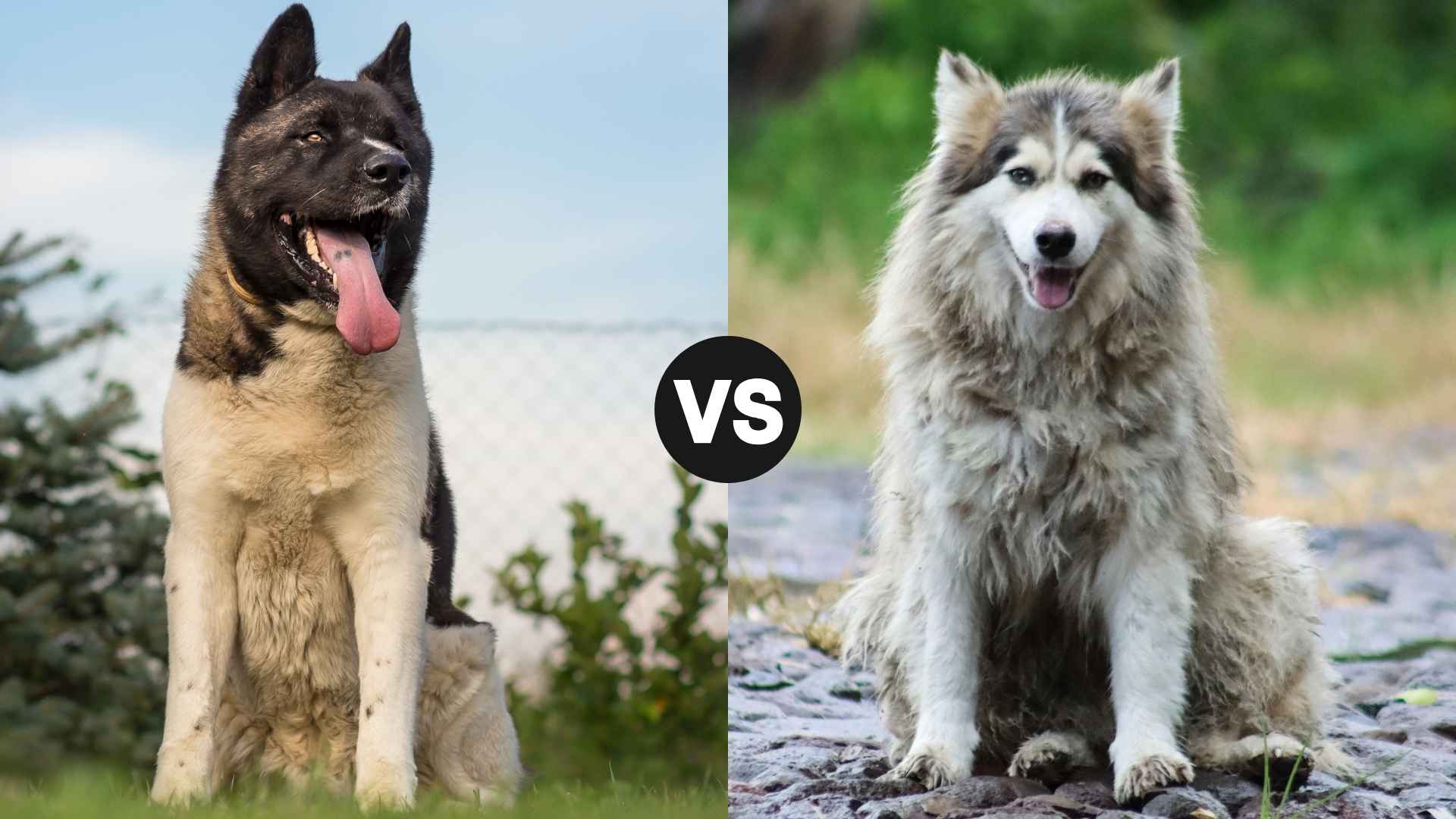Choosing between an Akita and an Alaskan Malamute can feel like picking between two majestic forces of nature. Both breeds boast stunning looks, powerful builds, and deeply loyal personalities—but that’s where their similarities start to diverge.
Whether you’re enchanted by the stoic, dignified gaze of the Akita or the wolf-like allure and boundless energy of the Alaskan Malamute, each breed brings a unique set of traits to the table.
The Akita, hailing from Japan, carries an air of nobility with its calm demeanor and strong sense of family loyalty. Meanwhile, the Alaskan Malamute, bred for pulling heavy sleds across icy landscapes, thrives on adventure, teamwork, and companionship.
While both dogs are protective and loving, their exercise needs, grooming demands, and social behaviors differ quite a bit. If you’re standing at the crossroads, unsure which of these beautiful breeds fits your lifestyle, you’re not alone.
This head-to-head comparison will break down everything from temperament and training to health and home life. Let’s dive in and discover which of these Arctic beauties could be your perfect four-legged partner.
Akita vs. Alaskan Malamute
Comparison of Size and Weight
When it comes to big, fluffy dogs that command attention, the Akita and the Alaskan Malamute both deserve a standing ovation (though good luck getting them both to fit on the stage at the same time). Let’s dive into their size, weight, and physical appearance, and what makes each breed a true showstopper.
Akita:
Hailing from the snowy mountains of northern Japan, the Akita carries centuries of noble tradition. According to the American Kennel Club (AKC), this double-coated muscular dog is famous for its dignity, courage, and loyalty.
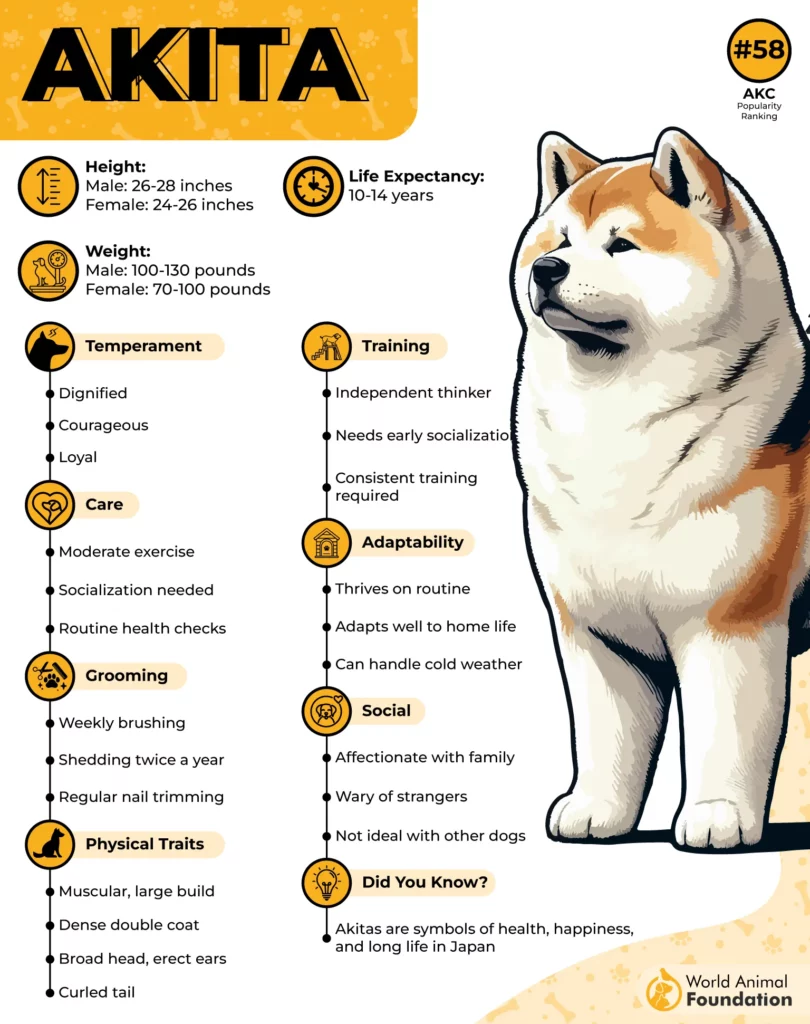
In Japan, they’re not just pets — they’re legends. Families once gifted Akita statues to wish health, happiness, and long life (because who wouldn’t want a good luck dog?).
Fun fact: Helen Keller brought the first Akita to the U.S. in 1937, making her an honorary trendsetter of the breed!
Size:
Weight: 70 – 130 lbs
Height: 24 – 28 inches
Face:
Broad head, small triangular eyes, and erect ears give them an almost bear-like look. Their curled tail sits proudly over their back like a royal flag.
Colors:
White, brindle, red, sesame, pinto — basically, they’ve got the whole color palette covered.
Coat:
Thick, plush double coat; can be short or slightly longer (“long coat” Akitas exist but are less common).
Alaskan Malamute:
Meanwhile, across the Pacific, the Malamute was originally bred by the Mahlemut Inupiat people of Alaska. These Arctic sled dogs hauled heavy freight across frozen landscapes long before snowmobiles were a thing.
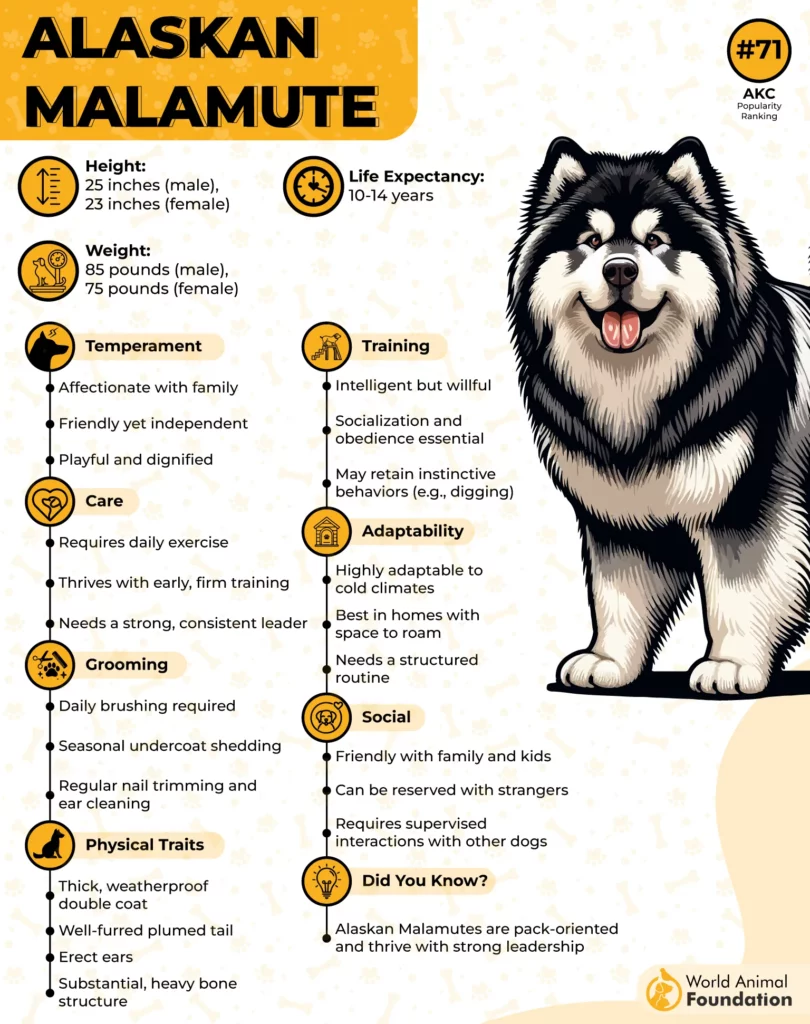
Built for endurance, not speed, Malamutes are the OG winter delivery service — kind of like a big, fluffy UPS driver, but way cuter. These fluffy dogs are known for their friendly, playful nature, and their impressive ability to redecorate your backyard if they get bored.
Size:
Weight: 75 – 100 lbs
Height: 23 – 25 inches
Face:
Strong, wolf-like head with expressive almond-shaped eyes, often with a playful sparkle. The signature facial mask adds extra personality.
Tail:
Big, fluffy, and curls over the back like a giant plume.
Coat:
Thick, dense, and built for Arctic life. Their coat is a winter-ready fur jacket.
Colors:
Shades of gray, black, sable, seal, and red — always with white markings on face, belly, legs, and tail tip.
Personality and Temperament Overview
When you bring home an Akita or an Alaskan Malamute, you’re not just getting a dog — you’re inviting a big, bold personality into your life. But while both breeds are beautiful and powerful, their personalities are surprisingly different. Let’s take a walk through what makes each of them tick.
Akita:
The Akita is like that calm, stoic person at the party who says very little, but when they speak, everyone listens. Originally from Japan, Akitas were bred to guard royalty and hunt big game like wild boar and bears, and that dignified history shows.
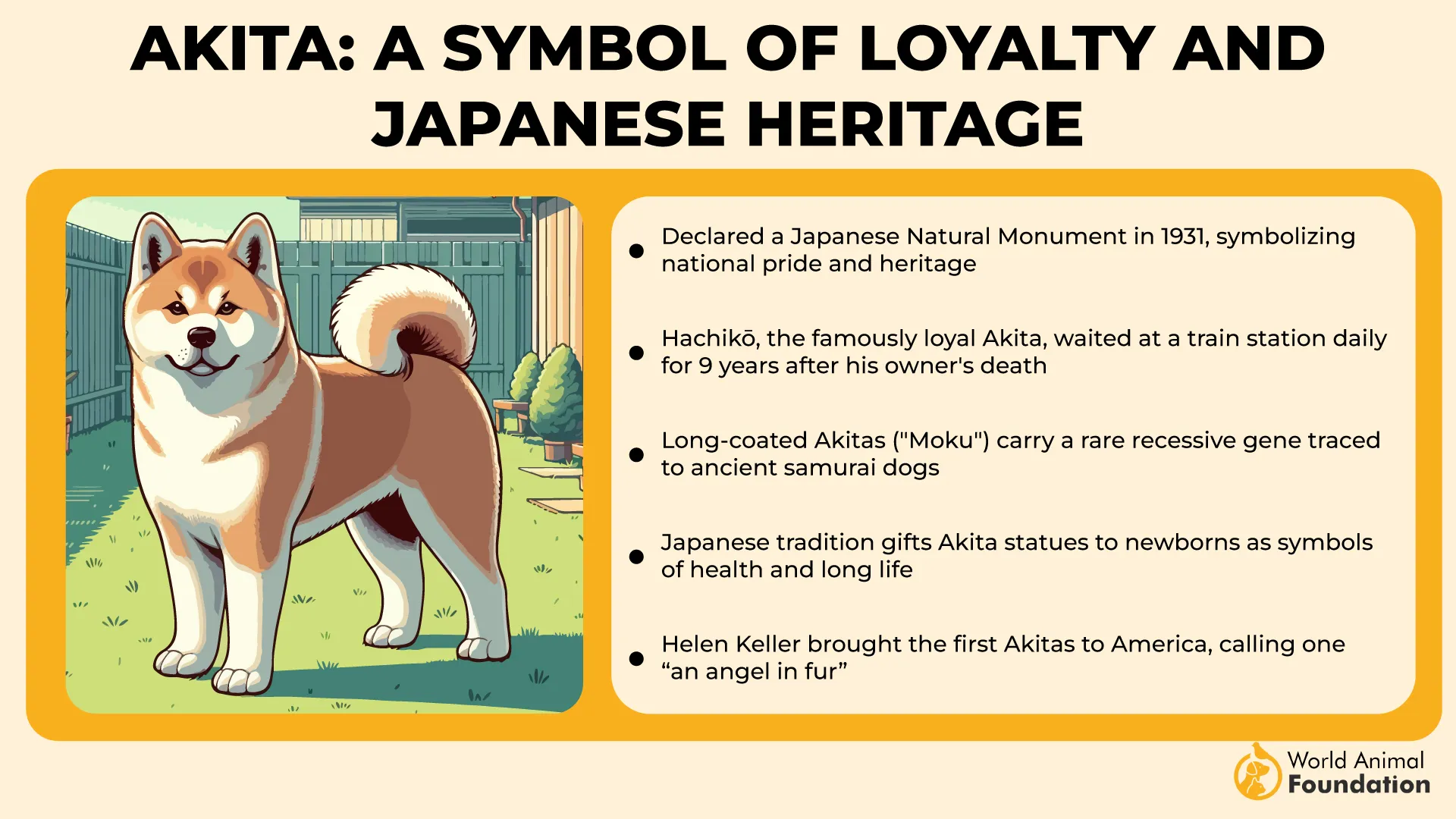
Main Personality Traits:
✅ They’re not hyper or bouncy — they exude quiet confidence.
✅ Known for being strong and silent — unless there’s a real reason to speak.
✅ They bond fiercely with their family and can be quite protective.
✅ PetMD noted Akitas are independent and strong-minded by nature; they need early and consistent training, along with proper socialization, to grow into well-rounded companions.
✅ Though dignified, they can be very loving and cuddly with their family.
✅ They’re happiest when they have a role — even if that role is “quiet house protector.”
Alaskan Malamute:
If the Akita is the serious samurai, the Alaskan Malamute is the big, fluffy extrovert who wants to pull sleds all day and throw a party after. Bred to haul heavy loads across frozen landscapes, Malamutes are strong, social, and surprisingly goofy.
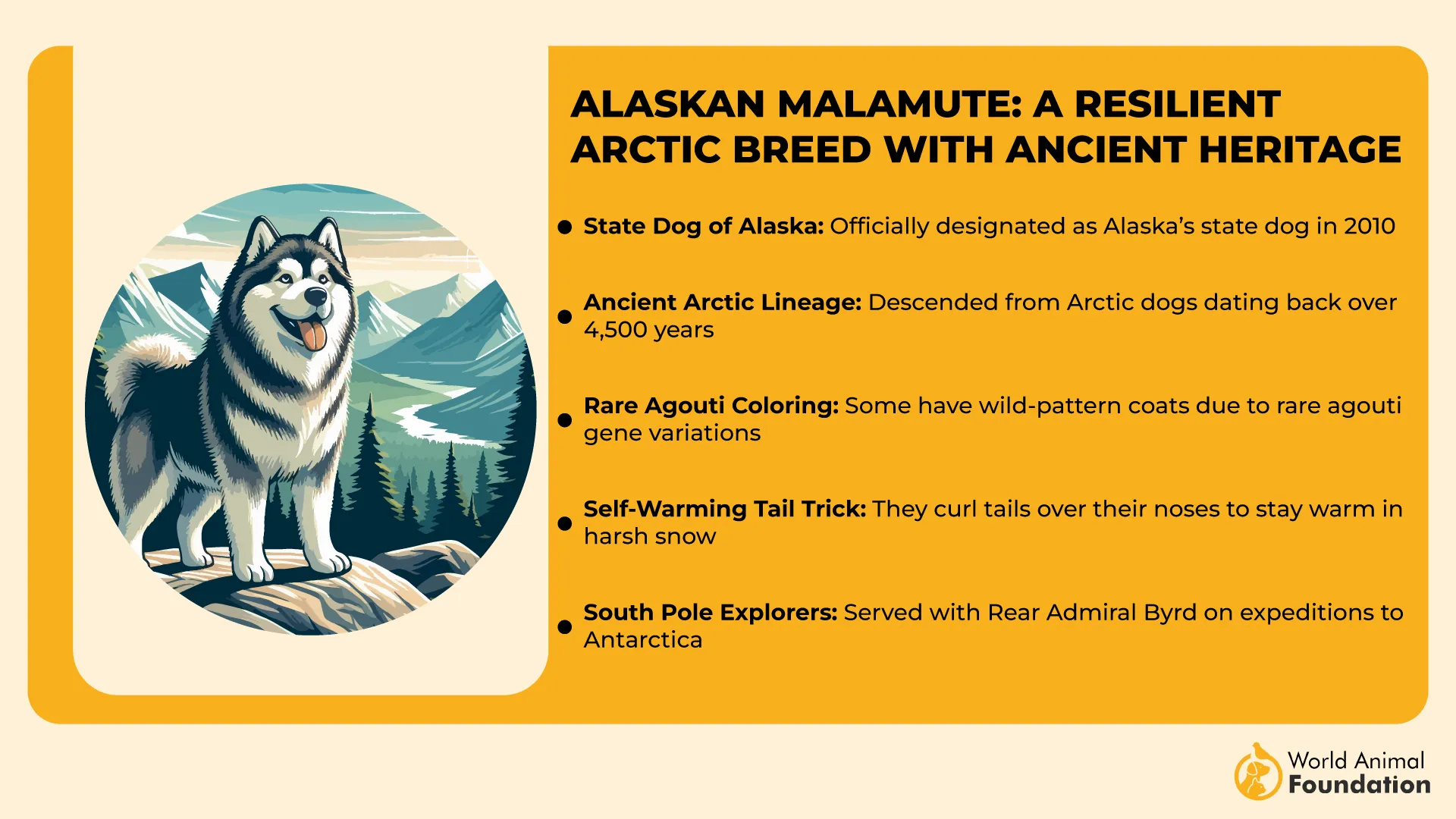
Main Personality Traits:
✅ Loves people, kids, and visitors (sometimes a little too friendly for a guard dog).
✅ They don’t bark much, but they do “talk” — woo-woo howls, grumbles, and all kinds of adorable noises.
✅ Total lovebugs who enjoy physical contact and lots of attention.
✅ Generally does well with other dogs, especially if raised together.
✅ They often act like big, mischievous puppies well into adulthood.
✅ They love to dig, shed like crazy, and occasionally redecorate your yard.
Adaptability and Level of Independence
When it comes to adapting to different lifestyles, both breeds can adjust, but with a few caveats.
Akita:
Adaptability:
Can adapt to different living situations (house, apartment, countryside), but needs space and mental stimulation.
Doesn’t always enjoy chaotic or high-traffic households.
Sensitive to heat, they prefer cooler climates.
Independence Level:
High.
Akitas don’t constantly seek attention. They enjoy affection but are perfectly content doing their own thing.
Can be stubborn — they listen when they feel like it. They are thinkers, not people-pleasers.
Reality Check: An Akita adapts best to calm, structured environments with experienced owners who can handle their strong will and confidence.
Alaskan Malamute:
Adaptability:
Needs space to roam or at least frequent outdoor adventures.
Not ideal for small apartments unless heavily exercised.
Also prefers cooler climates — they’re walking snow machines.
Independence Level:
Medium.
Malamutes enjoy company — both human and canine — and don’t love being left alone for long.
While they can be independent in decision-making (i.e., ignoring your recall if something more interesting appears), they thrive on social interaction.
Reality Check: Malamutes adapt best to active households where they get plenty of exercise, attention, and aren’t left alone for long stretches.
Bite Force and Jaw Characteristics
Now, don’t worry — neither of these breeds is looking to snack on your arm. But for those curious about canine chomp power, here’s the bite-sized truth:
Akita:
The Akita is no lightweight in the bite department. With a bite force estimated around 350 to 400 PSI (pounds per square inch), this dog has some serious jaw strength — enough to make you rethink that tug-of-war game.
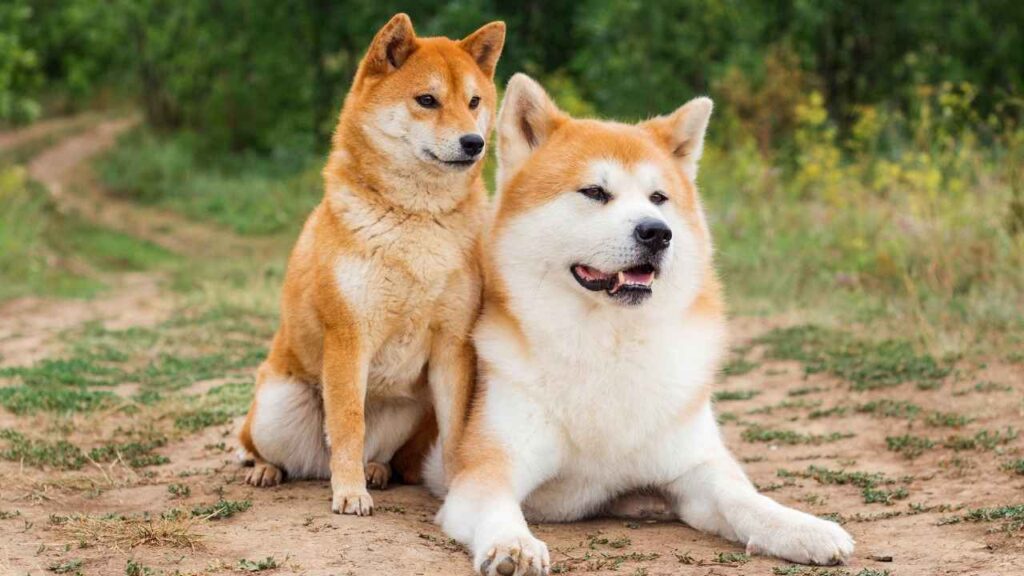
Their strong, broad skull and powerful jaws were built for hunting large game in ancient Japan, so it’s no surprise they have the bite to back it up. Thankfully, they’re not aggressive without reason, but they do require proper training and respect.
Alaskan Malamute:
Malamutes also pack a decent bite, with an estimated bite force in the range of 200 to 300 PSI. While that’s slightly less than the Akita, it’s still strong enough to crush bones and carry out serious sledding work (and perhaps disassemble your furniture if left unsupervised). Their jaws are built more for pulling and carrying than fighting — think “gentle giant with a mischievous streak.”
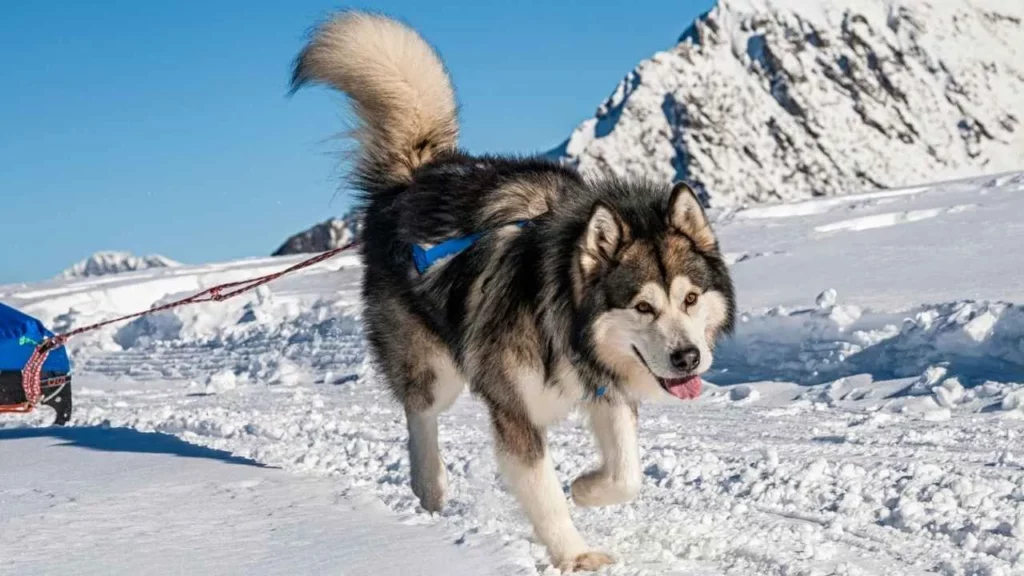
Bottom line: Both breeds have strong jaws and should be handled with care, especially around small children and other animals. Proper socialization is key — these aren’t Goldendoodles, after all.
Health Conditions and Lifespan Analysis
Nobody likes to think about the tough stuff, but understanding a breed’s health profile helps you prepare for the long run — and hopefully enjoy many happy, tail-wagging years together.
Akita:
Akitas generally live 10 to 13 years, which is pretty good for a large dog breed. They’re hardy but not invincible. Some common health issues include:

Hip dysplasia – Common in big dog breeds.
Progressive retinal atrophy (PRA) – Can lead to vision loss.
Autoimmune disorders – Akitas are more prone to these than many other breeds.
Hypothyroidism – Can cause weight gain, lethargy, and skin issues.
Bloat – A life-threatening emergency; always feed in smaller meals and avoid heavy exercise right after eating.
Because they tend to hide discomfort like true stoics, regular vet check-ups are a must — Akitas won’t send you a memo when something’s wrong.
Alaskan Malamute:
Malamutes also average a lifespan of 10 to 14 years, but they, too, come with a few potential health concerns:
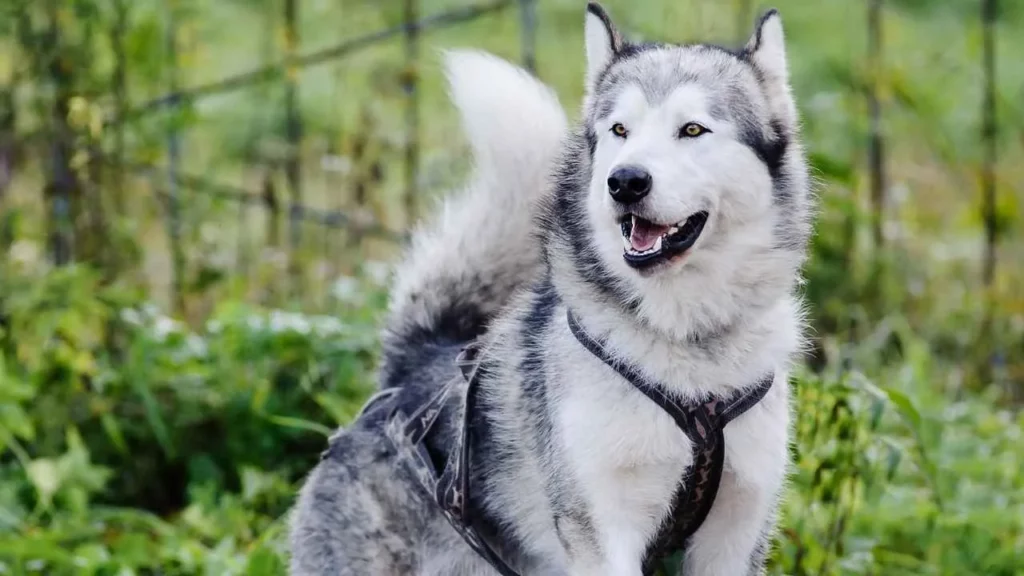
Hip dysplasia – Yep, same deal here.
Hypothyroidism – Similar to the Akita.
Cataracts – Can show up relatively early.
Chondrodysplasia – A type of dwarfism; breeders test for this.
Zinc deficiency – This can cause skin issues in Malamutes and needs dietary management.
Despite their working-dog strength, Malamutes need regular care and exercise to stay in top form. They’re not just snow beasts — they’re family members with fur and feelings.
Energy Levels and Daily Exercise Needs
Sure, they both look like snow-loving supermodels, but what’s life really like with an Akita or Alaskan Malamute when it comes to keeping them fit and fabulous? Let’s talk zoomies, brushing battles, and what to expect if you’ve got dog allergies.
Akita:
Akitas aren’t hyper. They’re not bouncing off the walls or chasing their tail in the living room (unless there’s a suspicious-looking vacuum). They’re more like a coiled spring — calm and composed most of the time, but very powerful when engaged.
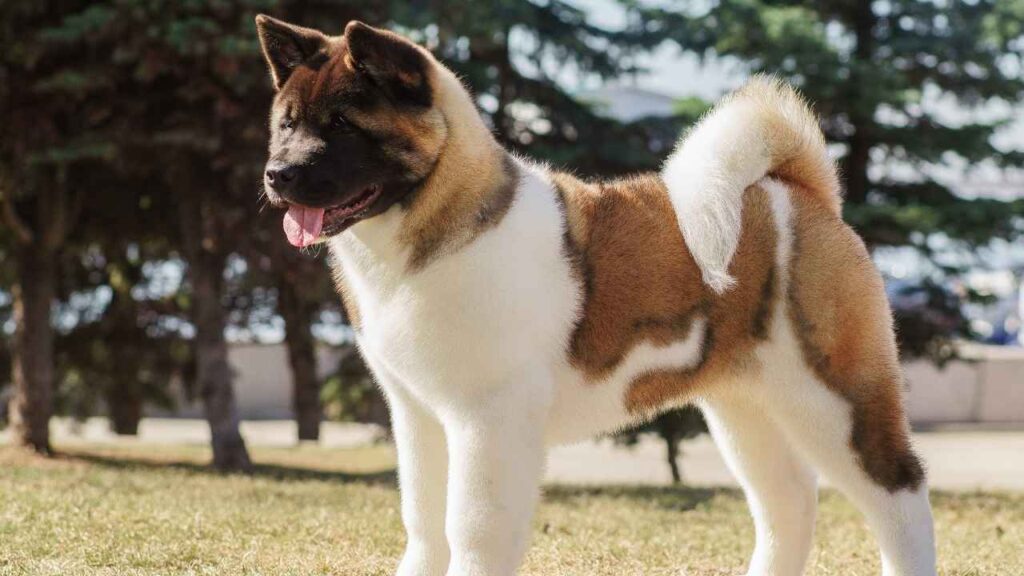
They need moderate daily exercise — about 30 to 60 minutes of activity a day is enough to keep them satisfied.
Don’t mistake their chill vibe for laziness, though. These dogs enjoy purposeful activities like walking, hiking, or structured playtime. Off-leash time? Only in secure areas. Akitas tend to be independent, and “selective hearing” is one of their special skills.
Alaskan Malamute:
Malamutes are pure energy wrapped in fluff. Bred to pull sleds across icy wilderness, they still carry that work ethic — and you’ll see it in your backyard, your living room, and possibly your neighbor’s garden if they dig under the fence.
Malamutes need lots of daily exercise — at least 1 to 2 hours, including walking, running, play, or structured work like weight pulling or agility.
As per Britannica, Alaskan Malamutes especially enjoy activities like sledding and weight-pulling, which play to their working dog roots. They also excel in various canine sports and competitions, including agility, obedience, and scent detection tasks. They thrive with a “job.” Without physical and mental outlets, they’ll invent their own hobbies… like home demolition or yard excavation.
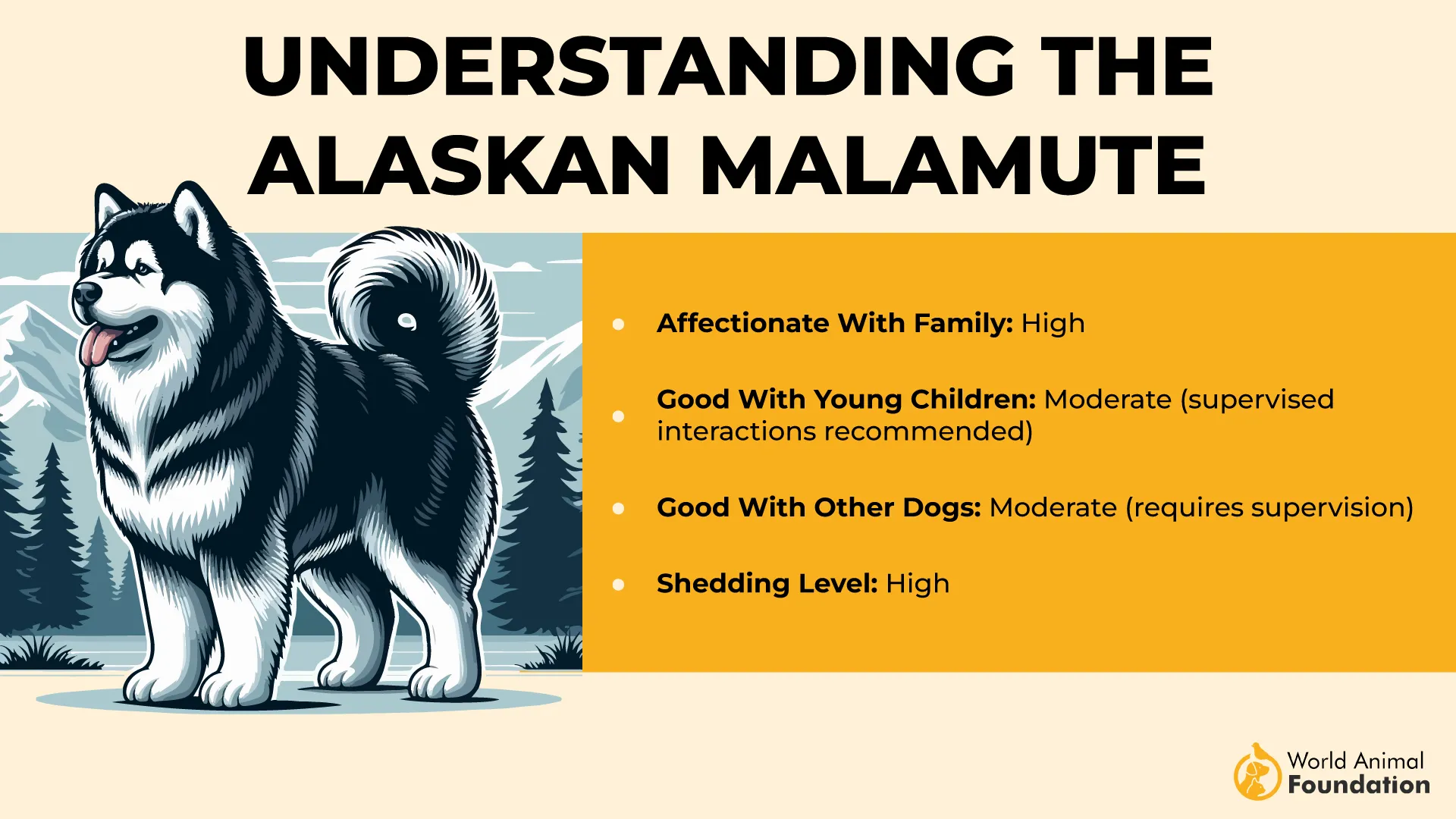
Grooming Requirements and Allergy Considerations
While both the Akita and Alaskan Malamute come dressed in thick, luxurious coats that turn heads, keeping them looking their best takes some regular effort — and a lot of fur management. Here’s what you need to know before your home turns into a snow globe of dog hair.
Akita:
Akitas are surprisingly low-maintenance most of the year, but when shedding season arrives, brace yourself. Their thick double coat means they have periods where you’ll wonder if you’re living with a dog or a walking fur factory.
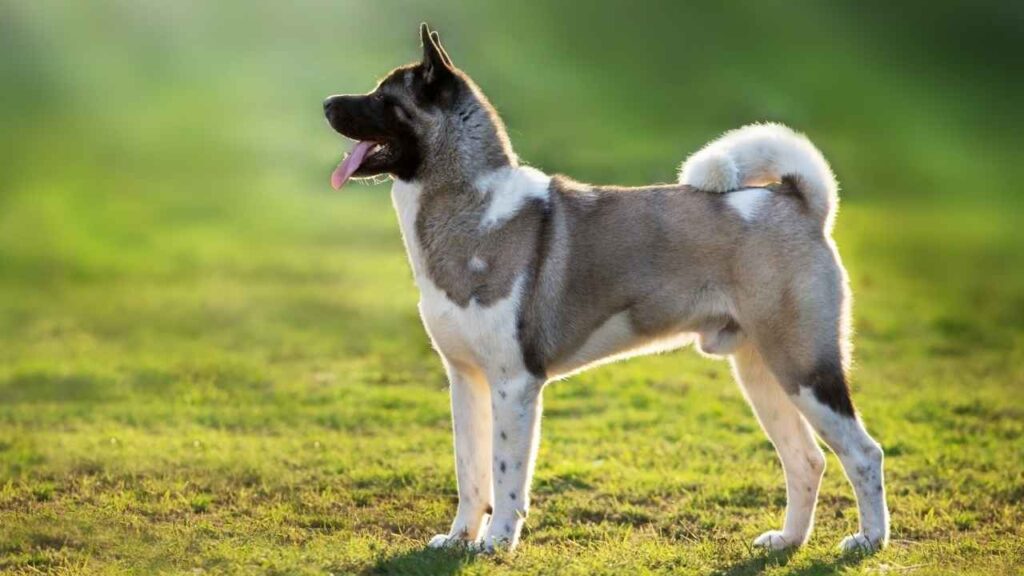
Brushing:
Light brushing once or twice a week for most of the year.
Daily brushing during seasonal shedding (spring and fall coat blowouts).
Bathing:
Every few months or as needed, Akitas are naturally clean dogs.
Shedding:
Heavy during coat-blow seasons; moderate the rest of the year.
Odor:
Low doggy odor — they’re pretty tidy for a large breed.
Allergies:
Not hypoallergenic. People with dog allergies may have issues, especially during heavy shedding periods.

In short, when they’re not shedding, grooming feels pretty easy. But during those coat-blow weeks? Get your brushes, combs, and lint rollers ready.
Alaskan Malamute:
Malamutes take grooming to another level — they practically turn your home into a winter wonderland year-round. With their thick, dense double coat, they shed heavily and require regular attention to keep that coat healthy.
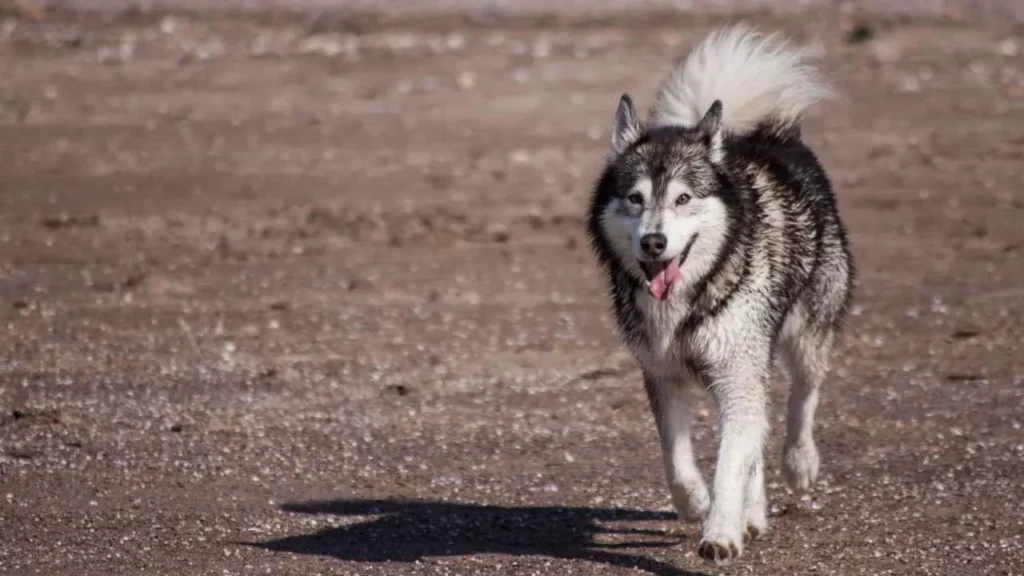
Brushing:
Minimum 2–3 times a week; daily brushing is strongly recommended during heavy shedding.
Bathing:
Every few months or when dirty. Malamutes have weather-resistant coats that don’t need frequent baths.
Shedding:
Heavy shedding year-round; extreme shedding during seasonal coat blows.
Odor:
Generally low odor, but the fluff gets everywhere.
Allergies:
Definitely not hypoallergenic. Allergy sufferers will likely struggle.
With a Malamute, grooming isn’t a chore — it’s a lifestyle. You’ll be brushing, vacuuming, and probably owning multiple lint rollers. But that luxurious coat? Absolutely stunning.
Conclusion
When comparing the Akita vs the Alaskan Malamute, both are large dogs with striking appearances and are known as highly intelligent, smart dogs. The Alaskan Malamute tends to excel with other sled dogs, built to pull over long distances, and was even used during World War II alongside many dogs. The Akita shows great courageous spirit and loyalty, often more reserved with strangers but deeply bonded with friends.
Despite their many admirable qualities, both breeds require dedicated, knowledgeable owners who understand their strong-willed personalities. They need proper training, early socialization, and firm but gentle leadership to bring out their best behavior.
Their independence, physical strength, and innate working instincts mean they thrive in homes where their mental and physical needs are consistently met. With the right care, both the Akita and the Alaskan Malamute are truly remarkable animals that can become loyal, loving, and rewarding companions.


